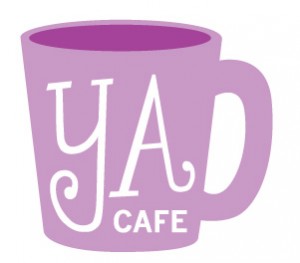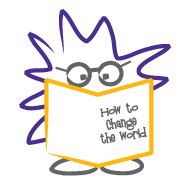 Welcome Back to YA Cafe, where book lovers can gather and chat about teen literature. I’m your barista, along with Ghenet from All About Them Words.
Welcome Back to YA Cafe, where book lovers can gather and chat about teen literature. I’m your barista, along with Ghenet from All About Them Words.
Each Friday we pick from a menu of topics and share our thoughts on our respective blogs. We’ve also got plans brewing for interviews, events and even some exciting giveaways, so stay tuned! Join the discussion by responding in the comments, on your own blogs or on twitter using the hash tag #yacafe.
Today, I’m going to get a little bit personal and I hope you bear with me. Because, let’s face it, body image IS personal and for me, this topic has long been intertwined both with my emotional identity and my identity as a writer. So here goes.
For as long as I can remember, I’ve been an observer in my own life, an outsider, a perfectly-acceptable-looking but nothing-special kinda girl. In fact, I think it’s no random coincidence that my current work-in-progress happens to be about a girl who’s totally ordinary. Because that’s the role I often played as a teen.
I think this is why Halloween was such an important part of my teenage life. I only stopped dressing up when I was well into graduate school. From my very first Halloween as a baby where I dressed as a fortune-teller, through my teen years and early twenties, Halloween was one of the most important nights of my year.
I can still remember the Halloween costumes I wore as a teenager. Age 13: Phantom of the Opera. Age 14: Nathan Detroit from Guys and Dolls. Age 15: A Brazilian soccer player (in honor of the World Cup the following summer). Age 16: Hobbes from Calvin and Hobbes. Age 17: Robin Hood. Looking back to the Halloween costumes of my high school years, it strikes me that they were all male personas, which is interesting in and of itself, but what’s more interesting is that the costumes themselves were complete opposites of my personality.
Phantom of the Opera: crazed-in-love and melodramatic. Nathan Detroit: bumbling but charming New York gangster. Brazilian soccer player: um, I’m the kid who purposely got “out” first when playing dodgeball so I could sit on the sidelines and read. And Hobbes? Well, I’ve always been more Calvin than Hobbes. Robin Hood was the only costume I related to on some level… I don’t know why but taking from the “haves” and giving to the “have-nots” has always been a theme that really resonated with me. (Those of you who’ve been around this blog long enough, will probably get a chuckle from that last understatement.)
Anyway, back to Halloween. I think the reason Halloween was so important to me was that being somebody else for the day gave me permission to step into the limelight. It was a way for me to abandon the quiet-Gabriela persona and take on a whole other personality. It pulled me out of my usual observer role, making me an active participant in the world around me. It was as though as long as I was in costume—as long as I was being somebody else—it was OK for me to draw attention to myself. It was perfectly acceptable for Robin Hood to take center stage, but not so for ordinary Gabriela.
The truth is that, Halloween costumes or not, I never fit in. It’s no coincidence that high school was about the time when I started keeping a regular journal, or as one of my classmates used to call it: “the b*tch book.” When I was writing, nobody judged me based on how I looked. It didn’t matter whether I’d mastered the art of eye-liner or if I was wearing the latest fashions from some teenie-bopper magazine. Writing didn’t have visual and audible cues, like facial expression or even tone of voice. All I had to work with were the words I put on the page and I was in complete control of what those words were. Writing allowed me to be another person and I could see the world through her eyes. Through this adopted identity, I could say and do things I would never do in real life. It let me act out all the daring, crazy or even downright-bad behaviors I wished I could do without actually suffering the negative consequences.
My journal collection has now reached a total of close to thirty notebooks with the earliest one dating back to when I was in fourth grade. I rarely reread these journals, and do so only when I need to remember a particular person or event. Otherwise, I prefer to leave the past in the past and simply keep these journals as totems marking the various landmarks of my life. They’re evidence, like existential graffiti. “GABRIELA WUZ HERE.” These journals are the proof.
I’ve often wondered what I would want done with them when I’m gone. If someone else were to read them I would die of embarrassment, even if I was already dead. At the same time, though, I couldn’t bear the idea of them being destroyed either. No, I think I would want them to be locked away someplace, maybe in a glass case in a library where no one has the key. That way people could know that they were there, but not actually see what was in them. Then even in death, I could be pseudo-invisible. The journals would exist and with them a record of my thoughts and opinions, but they would always be out of reach. Of course the irony is that if this did happen, people would only see the covers of the journals and they would never know what’s inside. I would be nothing more than a book being judged by its cover, and is that what I really want to be?
To read Ghenet’s take on body image as a teen, check out her YA Cafe post. Also, don’t forget to share what makes you beautiful and embrace your awesomeness with the hash tag #whatmakesmebeautiful on Twitter.











 Call me Gabi (pronounced gah-BEE). I'm a writer, freelance teacher, and a lover of books and words. I'm also the instigator of DIY MFA. iggi's my sidekick, but he thinks he's the brains behind this operation.
Call me Gabi (pronounced gah-BEE). I'm a writer, freelance teacher, and a lover of books and words. I'm also the instigator of DIY MFA. iggi's my sidekick, but he thinks he's the brains behind this operation.
 YA Cafe: New-and-Improved Book Club
YA Cafe: New-and-Improved Book Club Rock the ROW80
Rock the ROW80 ROW80 Goals Post
ROW80 Goals Post YA Cafe: Banned Books Week
YA Cafe: Banned Books Week